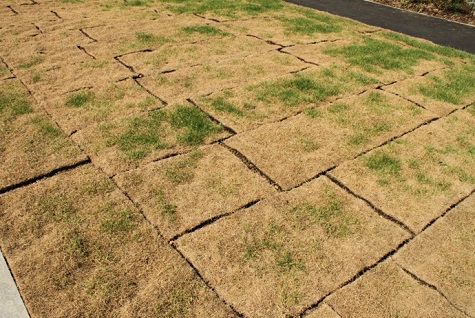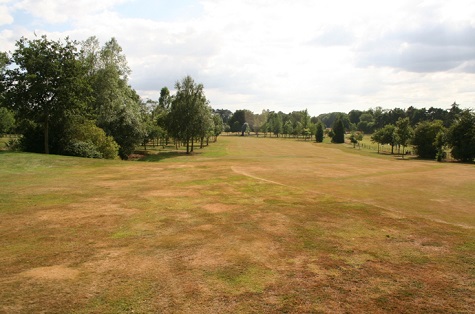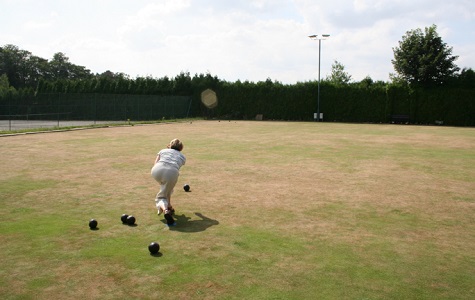I am sure many of us have either been basking in the sun or have hard at work during this spell of hot, dry weather. For those of you toiling away, don’t forget it’s so important to keep ourselves well hydrated throughout the day.
This hot weather, coupled with some windy days, is raising evapotranspiration rates which, over time, will have serious consequences to natural grass playing surfaces and our gardens if we cannot keep them watered.
Evapotranspiration refers to the combined process of evaporation and transpiration, where water is transferred from the earth's surface to the atmosphere in the form of vapour. It is an essential part of the earth's water cycle.

Evaporation involves the conversion of liquid water into water vapour, primarily from water bodies such as oceans, lakes, and rivers, as well as from moist soil surfaces. Transpiration, on the other hand, is the process by which plants absorb water through their roots and release it into the atmosphere through their leaves in the form of vapour.
Together, evaporation and transpiration contribute to the overall movement of water from the earth's surface into the atmosphere. They are influenced by various factors such as temperature, humidity, wind speed, solar radiation, and the availability of water.

Evapotranspiration plays a significant role in regulating the earth's climate system. It affects local and regional weather patterns, as well as the distribution of precipitation. It also influences the water availability for ecosystems, agriculture, and human water supplies. Measurement and understanding of evapotranspiration are important for managing water resources, predicting droughts, estimating crop water requirements, and studying the overall water balance of an area.
Evapotranspiration rates can have a significant impact on sports turf - here's how:
Water demand: Evapotranspiration rates determine the amount of water needed to maintain adequate soil moisture levels. Higher evapotranspiration rates indicate greater water loss from the turf, which means the turf requires more irrigation to compensate for the lost moisture. Understanding evapotranspiration rates helps turf managers establish appropriate irrigation schedules to prevent turf stress or dehydration.
Irrigation management: Evapotranspiration rates provide valuable information for efficient irrigation management. By monitoring evapotranspiration rates, turf professionals can determine the optimal amount and frequency of irrigation needed to replenish the lost water. This information helps prevent overwatering or underwatering, ensuring the turf receives adequate moisture for healthy growth.

Drought conditions: During periods of high evapotranspiration rates, such as hot and dry weather, the turf faces increased water stress. If the irrigation is not adjusted to match the evapotranspiration rates, the turf may suffer from drought conditions, leading to brown and unhealthy grass. Turf professionals need to closely monitor evapotranspiration rates during these conditions and make necessary adjustments to irrigation practices.
Performance and playability: The condition of sports turf greatly affects its performance and playability. Evapotranspiration rates play a role in maintaining optimal turf conditions for sports activities. Proper irrigation based on evapotranspiration rates ensures the turf remains firm, resilient, and able to withstand heavy foot traffic. Inadequate irrigation due to incorrect estimations of evapotranspiration rates can lead to overly soft or dry turf, affecting the playability and safety of sports surfaces.
Disease and pest control: High evapotranspiration rates can increase the stress on turf, making it more susceptible to diseases and pest infestations. When the turf is not adequately hydrated, it becomes weaker and less able to resist pathogens and pests. By managing irrigation based on evapotranspiration rates, turf managers can promote healthier turf and reduce the risk of disease outbreaks and pest damage.
In essence during prolonged periods of high evapotranspiration rates - combined with the fact that we are not watering as often - will lead us into a phase of drought conditions where our natural turf and garden plants become plant water deficient.
Plant water deficit, also known as water stress or drought, refers to a condition in which plants experience an insufficient supply of water to meet their physiological needs. Water deficit can occur due to various factors, including insufficient rainfall, high temperatures, low humidity, or poor irrigation practices. When plants are unable to access an adequate amount of water, they can exhibit several physiological and morphological responses.
Physiological responses to water deficit include stomatal closure, which is the partial or complete closure of small openings called stomata on the plant's leaves. Stomatal closure reduces water loss through transpiration but also limits the plant's ability to take in carbon dioxide for photosynthesis. As a result, photosynthesis and overall plant growth may be reduced.
To cope with water deficit, plants can also exhibit morphological adaptations. For example, some plants may reduce leaf size or shed leaves altogether to minimise water loss through transpiration. Additionally, plants can develop deeper root systems to access water from deeper soil layers or develop a waxy cuticle on their leaves to reduce water loss.
Prolonged or severe water deficit can have detrimental effects on plant health and productivity. It can lead to wilting, reduced growth, impaired nutrient uptake, decreased yield, and even plant death. Different plant species have varying tolerances to water deficit, with some being more drought-tolerant than others.
These periods of hot dry weather now seem to be becoming more regular, so perhaps we should be looking at finding ways to be more efficient on how we manage, store and utilise our current water supplies.
We essentially now need to start looking at ways of preventing plants from becoming water deficient with ways of managing our plants environment.
To mitigate the impact of water deficit on plants, various strategies can be employed. These include:

Proper irrigation: Providing plants with adequate and timely irrigation can help maintain soil moisture levels and minimise water stress.
Mulching: Applying a layer of organic mulch around the base of plants can help conserve soil moisture by reducing evaporation and weed competition.
Soil management: Improving soil structure and fertility through practices such as adding organic matter can enhance its water-holding capacity.
Plant selection: Choosing plant varieties that are adapted to local climate conditions and have higher drought tolerance can improve their resilience to water deficit.
Water conservation practices: Implementing water-saving techniques such as drip irrigation or using rainwater harvesting systems can help optimize water use.
Overall, managing plant water deficit involves a combination of water conservation practices, proper irrigation, and selecting appropriate plant species or varieties that are well-suited to the prevailing environmental conditions.